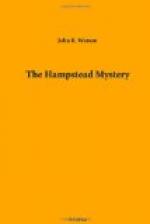The first witness was Miss Fewbanks. She was dressed in deep black and was obviously a little unnerved. In a low tone she said she had identified the body as that of her father. She was staying at her father’s country house in Dellmere, Sussex, when the crime was committed. She had no knowledge of anyone who was evilly disposed towards her father. He had never spoken to her of anyone who cherished a grudge against him.
Evidence relating to the circumstances in which the body was found was given by Police-Constable Flack. He described the position of the room in which the body was found, and the attitude in which the body was stretched. He was on duty in the neighbourhood of Tanton Gardens on the night of the murder, but saw no suspicious characters and heard no sounds.
The evidence of Hill was chiefly a repetition of what he had told Inspector Chippenfield as to his movements on the day of the crime, and his methods of inspecting the premises three times a week in accordance with his master’s orders. He knew nothing about Sir Horace’s sudden return from Scotland. His first knowledge of this was the account of the murder, which he read in the papers.
Inspector Chippenfield gave evidence for the purpose of producing the letter received at Scotland Yard announcing that Sir Horace Fewbanks had been murdered. The letter was passed up to the coroner for his inspection, and when he had examined it he sent it to the foreman of the jury. Then followed medical evidence, which showed that death was due to a bullet wound and could not have been self-inflicted.
The coroner, in his summing-up, dwelt upon the loss sustained by the Judiciary by the violent death of one of its most distinguished members, and the jury, after a retirement of a few minutes, brought in a verdict of wilful murder by some person or persons unknown.
As the occupants of the court filed out into the street, Crewe, who was watching Holymead, noticed the K.C. give a slight start when he saw Miss Fewbanks and his wife. Mr. Holymead went up to the ladies and shook hands with Miss Fewbanks, and to Crewe it seemed as if he was on the point of shaking hands with his wife, but he stopped himself awkwardly. He saw the ladies into their cab, and, raising his hat, went off. As Mr. Holymead had seen Miss Fewbanks in court when she gave evidence, it was obvious to Crewe that he could not have been surprised at meeting her outside. It was therefore the presence of his wife which had surprised him. That fact—if it were a fact—opened a limitless field of speculation to Crewe, but in spite of the possibility of error—a possibility which he frankly recognised—he was pleased with himself for having noticed the incident. To him it seemed to provide another link in the chain he was constructing. It harmonised with Taylor’s story of Mr. Holymead’s decision to stay at Verney’s instead of entering his own home the night Taylor drove him from Hyde Park Corner.




